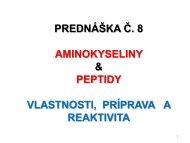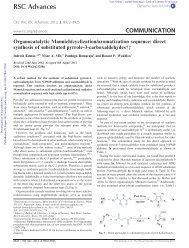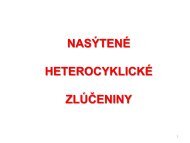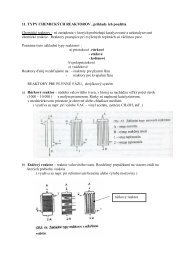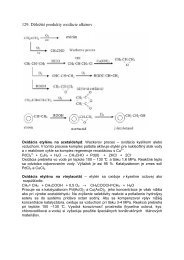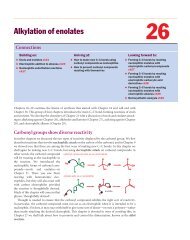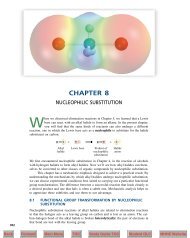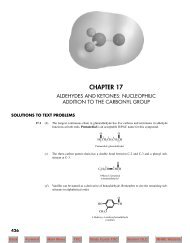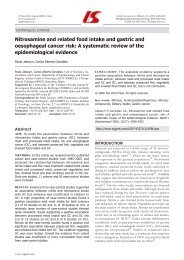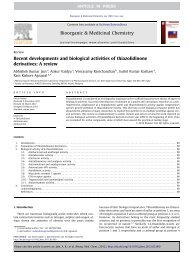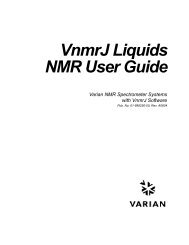Create successful ePaper yourself
Turn your PDF publications into a flip-book with our unique Google optimized e-Paper software.
Benzoyl isocyanate reacts with ethyl diazoacetate, in refluxing xylene, to give ethyl 1-benzoyl-5-hydroxy-1H-1,2,3-triazole-4-carboxylate<br />
in 60% yield (Scheme 33). [71]<br />
Scheme 33 Reaction of Benzoyl Isocyanate with Ethyl Diazoacetate [71]<br />
BzNCO + EtO 2CCHN2<br />
xylene, reflux<br />
60%<br />
EtO2C<br />
N<br />
N<br />
HO<br />
N<br />
Bz<br />
1-(4-Chlorophenyl)-1H-1,2,3-triazole (77, R 1 = 4-ClC 6H 4); Typical Procedure for the Reaction<br />
of Isocyanates with [Diazo(trimethylsilyl)methyl]lithium: [70]<br />
To 2 M TMSCHN 2 in hexane (0.6 mL, 1.2 mmol) in Et 2O (10 mL) was added dropwise, 15%<br />
BuLi in hexane (0.76 mL, 1.2 mmol) at 08C under argon. The mixture was stirred at this<br />
temperature for 20 min. A soln of 4-chlorophenyl isocyanate (154 mg, 1 mmol) in Et 2O<br />
(3 mL) was then added dropwise at 0 8C. The mixture was stirred at 0 8C for 2 h and ice water<br />
was then added. The aqueous layer was separated and the organic phase was extracted<br />
with H 2O. The combined aqueous layer was acidified with 2 M HCl. The resulting white<br />
precipitates were collected by filtration, dried in vacuo, and purified by column chromatography<br />
(silica gel) to give 77 (R 1 = 4-ClC 6H 4); yield: 162 mg (83%).<br />
<strong>13</strong>.<strong>13</strong>.1.1.2.1.3.4 Variation 4:<br />
From Diazoalkanes and Isothiocyanates<br />
Treatment of isothiocyanates with [diazo(trimethylsilyl)methyl]lithium (48) in tetrahydrofuran,<br />
followed by quenching with alkyl halides, gives 1-substituted 5-(alkylsulfanyl)-<br />
4-(trimethylsilyl)-1H-1,2,3-triazoles 78 in excellent yields (Scheme 34). [72] A dramatic solvent<br />
effect is observed in this reaction: changing tetrahydrofuran for diethyl ether leads<br />
to the exclusive formation of 1,3,4-thiadiazol-2-amines in good yields. [73] This is in contrast<br />
to the results observed with isocyanates (Scheme 32). Removal of the trimethylsilyl<br />
group from 78 is readily carried out with 10% aqueous potassium hydroxide in boiling<br />
methanol to give triazoles 79 in almost quantitative yields. [72]<br />
Scheme 34 Reaction of Isothiocyanates with [Diazo(trimethylsilyl)methyl]lithium [72]<br />
Li<br />
TMS<br />
48<br />
N 2<br />
+ R 1 NCS<br />
FOR PERSONAL USE ONLY<br />
436 Science of Synthesis <strong>13</strong>.<strong>13</strong> 1,2,3-<strong>Triazoles</strong><br />
THF<br />
R 2 X<br />
R1 +<br />
N2 N<br />
TMS<br />
Li<br />
S −<br />
78<br />
N<br />
N<br />
N<br />
R1 OH −<br />
Li + − S<br />
A. C. TomØ, Section <strong>13</strong>.<strong>13</strong>, Science of Synthesis, 2004 Georg Thieme Verlag KG<br />
TMS<br />
R 2 S<br />
TMS<br />
N<br />
N<br />
N<br />
R1 R 2 S<br />
79<br />
N<br />
N<br />
N<br />
R1



